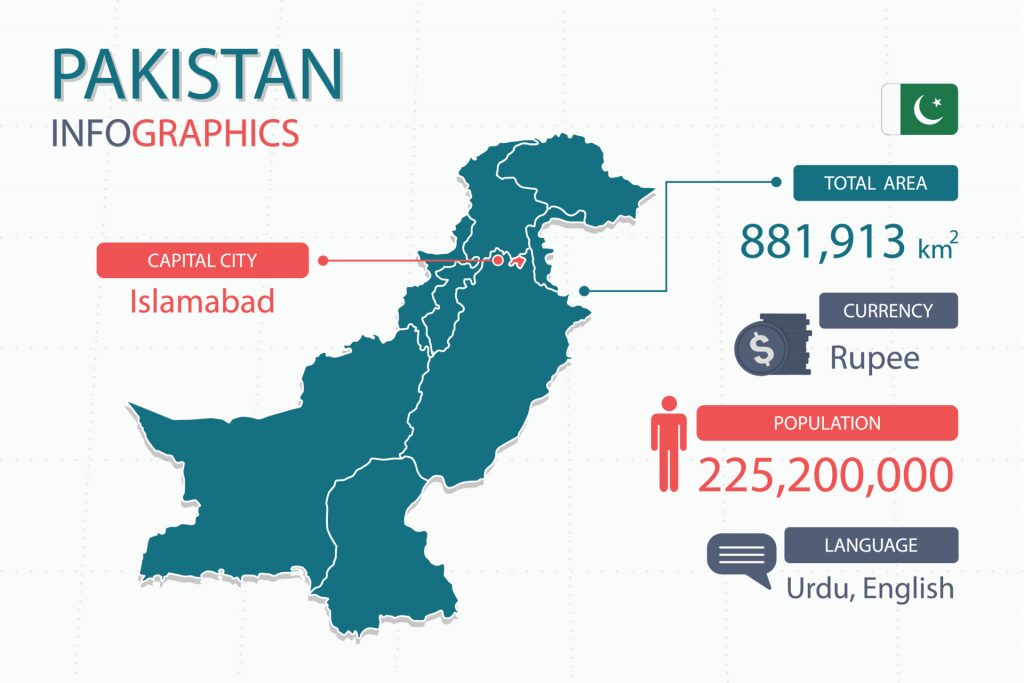The origins of the Urdu Language
Urdu is the official language of Pakistan. It also has official status in a number of states in India, including Jammu and Kashmir, Telangana, Utar Pardesh, Bihar, and Jharkhand. There are about 81 million speakers of Urdu, the majority of them being in India and Pakistan. The Urdu language is usually more associated with Muslim populations, as opposed to other religious groups, especially when discussing India.
Standard Urdu is considered a standardized version of the Hindustani language, along with standardized Hindi. It is also mutually intelligible with Hindi. Many linguists and academic scholars consider the two standards dialects of the same language, depending on how one politically defines a language. However, the individuals in their respective speech communities consider them separate languages. While they are mutually intelligible, there are a few differences. The largest difference pertains to the writing. Urdu is written using the Nastaliq style of the Persian alphabet, due to historical influences of Persia in areas of Pakistan and India. Second, much of the Persian and Arabic influenced vocabulary is preserved in Urdu, while speakers of Hindi tend to use Sanskrit-based vocabulary. In addition, technical and literary vocabulary in Standard Urdu tend to be created through newly coined terms, and the inspiration for their creation comes from Persian and Arabic, while Hindi terms are more often derived from Sanskrit.
The settlement of the Hindi-Urdu controversy in 1950 marked Standard Urdu as an official language. This controversy put into question whether Hindi and Urdu were separate languages, or dialects of the same language, Hindustani. While officially, the controversy is resolved, many scholars still argue about whether Hindi and Urdu are two different varieties or if they are simply the same language. However as time passes on, and the two varieties develop on their own and in different regions, namely India and Pakistan, differences continue to increase as more Urdu-specific vocabulary and Hindi-specific vocabulary is developed, and as the speakers of the respective language emphasize their unique characteristics.

The settlement of the Hindi-Urdu controversy in 1950 marked Standard Urdu as an official language. This controversy put into question whether Hindi and Urdu were separate languages, or dialects of the same language, Hindustani. While officially, the controversy is resolved, many scholars still argue about whether Hindi and Urdu are two different varieties or if they are simply the same language. However as time passes on, and the two varieties develop on their own and in different regions, namely India and Pakistan, differences continue to increase as more Urdu-specific vocabulary and Hindi-specific vocabulary is developed, and as the speakers of the respective language emphasize their unique characteristics.
A standardized version of the Hindustani language, it shares many of the same characteristics of Hindi, especially at a grammatical level. First, it is a Subject-Object-Verb language, where the verb usually comes at the end of a sentence. However, the word order is extremely flexible. Like Hindi, there are two genders and multiple cases. These factors allow for a flexible word order, as the grammatical role of the elements of a sentence are clear.
The Urdu writing system is what truly differentiates it from Hindi. The Urdi alphabet is an original alphabet that is actually a modification of the Nastaliq style of Persian, a calligraphy-like version. A style comparable to this might be cursive Latin letters as compared to print letters. Like Arabic, it is written from right-to-left. The Urdu alphabet itself contains 58 total letters. Urdu does not contain standalone vowels like English does, but there are marks that precede consonants to donate shifts in vowel sounds.
Looking at Urdu’s history, an understanding of the language stemming from Hindustani is required. Hindustani has roots in the Shauraseni language, which also is the source of many other languages in India, including Punjabi. Two main sources of vocabulary and grammar inform Standard Urdu. First, roots in Sanskrit are evidenced in the verbs. Second, Persian and Arabic have contributed a large amount of vocabulary and terminology, especially to formal speech. This preservation of Persian and Arabic vocabulary characterizes Standard Urdu and differentiates it from Hindi.
Historically, Urdu itself is a derivation of a Turkic term ordu meaning army. This is the same root of the word ‘horde’ in English. The Hindustani that the Persian armies spoke during the Muslim conquests in India was referred to as ‘the language of the ordu.’ Slowly, the word ordu was simplified to Urdu. Up until the 18th century on the Indian subcontinent, Persian was the main language of administration and a general language of prestige.
However, during the British occupation of India under the British Raj, Persian was displaced as the language of administration and official matters. Instead, this honor was bestowed to Hindustani. At this time, Hindustani was written used the Persian script, and the name Urdu was used to describe the language. Because of such factors, the Hindi-Urdu controversy was ignited as Hindustani speakers of Brahman descent and of the Hindu religion preferred Hindustani to be written in Devanagari, a script native to India. They also considered the variety of Hindustani that they spoke a separate language due to deeply formed religious and ethnic identity. At this point, Urdu split from Hindi with Hindi being based on a more literary form stemming from Sanskrit, while Urdu was more identified with Muslims and its Persian influences.
Ever since the split of Hindi and Urdu, there have been attempts on both sides to purify both languages to reflect their respective cultural roots, and in turn, to differentiate even further the characteristics of each language. In terms of Urdu, these efforts include replacing Sanskrit based words with Persian and Arabic based words, as new vocabulary tends to draw inspiration primarily from these two sources.
Nowadays, the Urdu language is defended passionately by its speakers. It is often contrasted with Standard Hindi, even though differences still are largely restricted to the alphabet, as speakers of Urdu understand speakers of Hindi and vice-versa, even though vocabulary choices among speakers of each respective language might be different. For example, speakers of Urdu do tend to use more Persian-based vocabulary in daily speech, while speakers of Hindi tend to use Sanskrit-based vocabulary. In terms of cultural artefacts and due to its association with a Pakistani identity, there has been a recent literary tradition that has emerged. The first novel in Urdu is considered to have been published in 1869, but Urdu literature highlighting everyday life in Pakistan has flourished, especially after Pakistani independence in 1947. In addition, ghazal is a genre of Urdu poetry that has become popular in the recent decade.
VEQTA can provide you with a perfect Urdu translator for your Urdu translation, English to Urdu translation and Urdu to english translation for the your targeted locale. Our translations to Urdu are created with your target audience in mind to meet your expectations.
If you need to translate Urdu – Get in touch today!
A dedicated team of Urdu translators who combines Experience, Specialized Subject Matter Expertise with best Translation Practices to deliver quality second to none.
Urdu Subject Expertise
Urdu Translators
Urdu Editors
Urdu Copywriters
Urdu Reviewers
Urdu Voice dubbing
Urdu Subtitling
Urdu Transcription


